|





|
For more details about these
eight historic personalities click on each name above
↑ |
|
 |
 |
 |
|
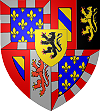
Capital
city:
Dijon
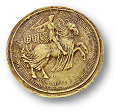
Philip of Burgundy
(called the Good) |
Philip of Burgundy
10
September 1419–15 June 1467
|
Philip
became Duke of Burgundy,
count of Flanders,
Artois
and
Franche-Comté
when his father was
assassinated
in 1419. Philip accused Charles, the
Dauphin of France and Philip's
brother-in-law of planning the
murder of his father which had taken
place during a meeting between the
two at Montereau. |
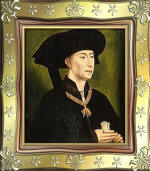
Philip of Burgundy |
|
He continued to prosecute the
civil war between the Burgundians
and Armagnacs.
In 1420 Philip allied himself with
Henry V of England under the Treaty
of Troyes. In 1423 the alliance was
strengthened by the marriage of his
sister Anne
to John, Duke of
Bedford,
regent for Henry VI of England. |
Trivia
Order of the Golden Fleece
founded in Bruges by Philip of
Burgundy 1430

Charles the Bold, son of
Philip of Burgundy
1433 - 1477 last of the Valois Dukes
of Burgundy

|

|
 |
 |
 |
|
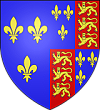
Capital
city:
London

Henry VI |
Henry VI
(31 August
1422 – 4 March 1461)
|
Henry
was the only child and heir of King
Henry V of England. He was born on 6
December 1421 at Windsor, and
succeeded to the throne at the age
of nine months as
King of England on 31 August
1422, when his father died, and King
of France on 21 October 1422 upon
his grandfather Charles
VI's death in agreement with
the Treaty of Troyes in 1420. His
mother, Catherine of Valois, was
then 20 years old and, as Charles
VI's daughter, was viewed with
considerable suspicion and prevented
from having a full role in her son's
upbringing. |

Catherine de Valois |
The Hundred Year
Wars
between
France and England
1337 - 1453
|
The
death of Charles IV in 1328 without
male heirs ended the main Capetian
line. Under Salic law the crown
couldn't pass through a woman
(Philip IV's daughter was Isabella,
whose son was Edward III of
England), so the throne passed to
Philip VI, son of Charles of Valois.
This, in addition to a long-standing
dispute over the rights to Gascony
in the south of France, and the
relationship between England and the
Flemish cloth towns, led to the
Hundred Years' War of 1337-1453. The
following century was to see
devastating warfare, peasant revolts.
Calais
remained in English possession until
1558 and the title of King of France
was claimed by the British until 1
January 1801 |

|

|
 |
 |
 |
|

Capital
city:
Perth
(St. John's Town)
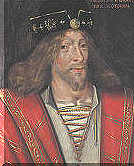
James the First |
James the First
(10
December 1394 – 21 February 1437)
|
King of
Scotland and poet, the son of King
Robert III., was born at Dunfermline
in July 1394.
James the
First, was a prisoner of the English
until 1424. He returned to Scotland
with his English bride Lady Joan
Beaufort, the niece of King Henry
IV. King James and Queen Joan were a
true love match - he wrote beautiful
poetry for her called "The King's Quair". Their daughter Princess
Margaret married Dauphin Louis in
1436. James
I was killed in 1437 and his son
became James II |
|
"Auld
Alliance"
Sir Hugh
Kennedy
|
Many thousands of Scots went to
France to fight the English in the
Hundred Years War. Charles VII
trusted them as his Garde
Ecossaise. Many Scots,
including
Sir Hugh Kennedy, were
with Joan of Arc throughout her
crusade, and played the tune 'Marche
de Robert Bruce' when she entered
Orleans. The special friendship
between France and Scotland is still
known as the "Auld
Alliance". |
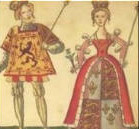
King James & Queen Joan Beaufort
parents of Margaret of Scotland
future wife of King Louis X1 of
France |

|
 |
 |
 |
|

Capital
city:
Lissabon
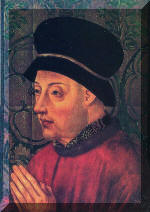
John the First of
Portugal |
John the First
of
Portugal
(João I)
|
11. April 1357 - 4. August 1433
was the tenth
King of Portugal and the Algarve and
the first to use the title Lord of
Ceuta. He was the natural son of
Peter I by a woman named Teresa
Lourenço, who some say was a noble
Galician, daughter of Lourenço
Martins, o da Praça, and wife Sancha
Martins. In 1364 he was created
Grand Master of the Order of Aviz,
by which title he was known. He
became king in 1385, after the
1383–1385 Crisis.
John I married at Oporto on 2
February 1387 Philippa of Lancaster,
daughter of John of Gaunt, 1st Duke
of Lancaster and Blanche of
Lancaster. From that marriage were
born several famous princes and
princesses of Portugal (infantes)
that became known as the Illustrious
Generation <<Dudenha>> |
|
|
During
the 15th and 16th centuries, as the
result of maritime exploration,
Portugal established a global empire
that included possessions in Africa,
Asia and South America, becoming one
of the world's major economic,
political and military powers.
His daughter
Isabelle Infanta 1397 - 1471 of
Portugal, married Philip of Burgundy
in 1430. She was the mother of
Charles le Téméraire |
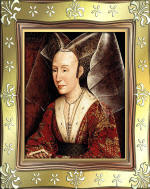
Isabelle of Portugal
Mother of Charles the Bold |

|
 |
 |
 |
|
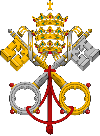
Capital
city:
Rome
1404 - 1406:
Pope Innocent
VII
1406 - 1415: Pope Gregory XII
1417 - 1431: Pope Martin V
1431 - 1447: Pope Eugene IV
. |
The Popes
at the
time of «
Catherine
»
|
The Popes
of the Middle Ages became powerful
and highly influential. This was the
period of the crusades where
thousands of Medieval people from
all walks of life travelled nearly
three thousand miles to the Holy
Land. The Militant religious zeal of
the popes and the promise of
redemption from sins made the
crusades popular. The Catholic
church became the universal and
unifying institution. The religious
fervour of the Popes of the Middle
Ages transferred into medieval
culture. A centralized Catholic
church was realized under Pope
Innocent III. The church and the
power of the Popes was eventually
weakened by quarrels between church
and state. |
|
|
In
Europe during the Middle Ages the
only recognised religion was
Christianity, in the form of the
Catholic religion. The lives of the
Medieval people of the Middle Ages
was dominated by the church. From
birth to death, whether you were a
peasant, a serf, a noble a lord or a
King - life was dominated by the
church. Various religious
institutions became both important,
rich and powerful. The lives of many
Medieval people were dedicated to to
the Catholic church and religion.
|

|

|
 |
 |
 |
|
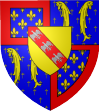
Capital
city:
Naples
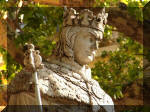
René d'Anjou
|
René d'Anjou
King of Naples
(16 January 1409 – 10 July 1480)
|
rival claimant to
Alfonso V of Aragón and
Ferrante I
of Naples), duke of Anjou, Bar, and
Lorraine, count of Provence. He was
also called René of Anjou and Good
King René. The second son of King
Louis II of Naples, he was count of
Guise when he married (1419)
Isabella, heiress of Lorraine and
Bar. He inherited Bar (1430) and
Lorraine (1431), but the latter
title was contested by a rival
supported by Philip the Good of
Burgundy. |

Jeanne de Laval
René d'Anjou's second wife
|
|
René
was captured (1431) and held
prisoner, although Holy Roman
Emperor Sigismund awarded him
Lorraine. At the death (1434) of his
brother, Louis III of Naples, he
inherited Anjou, Provence, and the
claim to the succession of Joanna II
of Naples (d. 1435), who adopted him
as heir. Released from his
imprisonment in 1437, René arrived
(1438) in Italy to take possession
of his kingdom. Alfonso V, who had
taken over the kingdom when Joanna
died, defeated (1442) him; René
returned to France and established a
brilliant court at Angers. |
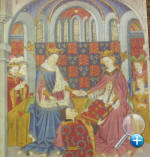
Margaret d'Anjou
daughter of King Rene d'Anjou
became wife of Henry VI of England
|

|
 |
 |
 |
|
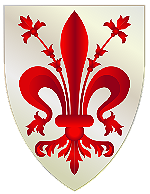
Capital
city:
Florence
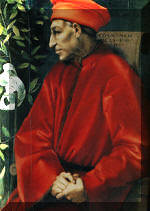
Cosimo de Medici
|
Cosimo de Medici
(September
27, 1389 – August 1, 1464)
The Medicis' Florence
|
Còsimo di
Giovanni of the Medicis was the
first of the Medici political
dynasty, de facto rulers of
Florence during most of the Italian
Renaissance; also known as "Cosimo
'the Elder'" ("il Vecchio") and "Cosimo
Pater Patriae".
The son of Giovanni
di Bicci de' Medici, Cosimo de'
Medici succeeded his father as the
head of the Medici Bank. He played a
prominent role in the government of
Florence until his exile in 1433,
after a disastrous war with
Tuscany’s neighbour, the Republic of
Lucca Cosimo's exile in Venice
lasted for less than a year, when
the people of Florence overturned
Cosimo’s exile in a democratic vote.
Cosimo returned to the acclaim of
his people and the banishment of the
Albizzi family, who had exiled
Cosimo. He
was a patron of scholarship and the
arts, including such figures as
Donatello and Filippo Brunelleschi. |
|
Republic of Florence
|
The
Republic of Florence was a
city-state that was centered on the
city of Florence, located in modern
Tuscany, Italy. The republic was
founded in 1115, when the Florentine
people rebelled against the
Margraviate of Tuscany upon
Margravine Matilda's death. The
Florentines formed a commune in
Matilda's place. The republic was
ruled by a council, known as the
signoria. The signoria was chosen by
the gonfaloniere (titular
ruler of the city), who was elected
every two months by Florentine guild
members. The republic has a
chequered history of coups and
counter coups against various
factions. The Medici faction gained
control of the city in 1434, upon
Cosimo de' Medici's counter coup
against the faction that sent him
into exile the previous year. The
Medici kept control of Florence
until 1494 |

Map of
Florence 1490 |

|
 |
 |
 |
|

Visconti
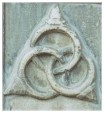
Sforza
Capital
city:
Milan
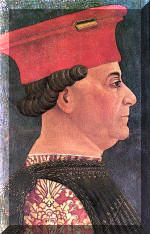
Francesco Sforza
|
The Visconti and Sforza in Milan
Filippo Maria
Visconti
23 September 1392–13
August 1447
|
Filippo Maria
Visconti, who had become nominal
ruler of Pavia in 1402,
succeeded his assassinated
brother Gian Maria Visconti as
Duke of Milan in 1412. They were
the sons of Gian Galeazzo
Visconti, Gian Maria's
predecessor.From
Filippo's marriage to Beatrice
Lascaris, Countess of Tenda and
the unhappy widow of Facino
Cane—the condottiere who had
fomented strife between the
factions of Filippo's elder
brother and his mother, Caterina
Visconti, the regent, Filippo
Maria received a dowry of nearly
half a million florins; but when
Beatrice took too great an
interest in affairs of state, he
accused her of adultery and had
her beheaded at the castle of
Binasco in 1418.
Cruel, paranoid and
extremely sensitive about his
personal ugliness, he was
nevertheless a great politician,
and by employing such powerful
condottieri as Carmagnola,
Piccinino and Francesco Sforza,
he managed to recover the
Lombard portion of his father's
duchy. |
|

Lodovico Maria Sforza
(Il Moro)
son of Francesco Sforza
died as prisoner in France (Chateau of Loches) |

Filippo Maria
Visconti |
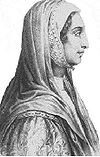
Beatrice Lascaris,
Contessa
de Tende |
|

Catherine Sforza of Imola and Forli
the woman Juliette Benzoni
admired
for her courage and beauty
|
Filippo
Maria tried to re-establish his
father's (Giangaleazzo
Visconti)
policies but by then surrounding
states were better prepared to
resist Milanese expansion. He died
without heirs and his daughter,
Bianca, married Francesco Sforza,
(grandfather
of the famous and beautiful Caterina
Sforza) one of the most
powerful mercenary captains in
Milan. After three years of trying
to establish republican government,
the Milanese asked Sforza to step in
and restore order in 1450. Having
settled the situation, Sforza
declared himself to be the successor
to the Visconti dynasty through his
wife and ruled as Duke of Milan
until his death in 1466. |
Trivia
|
The first known Tarot
decks,
then still called
Trionfi cards,
were commissioned
by
Filippo Maria Visconti |
|

|

|
 |
 |
|
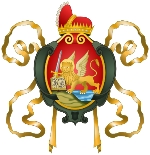
Capital
city:
Venice

The Venetian
colonies
|
Venice
Serenissima
Repubblica di
Venezia
Doges of Venice
Tommaso Mocenigo
1414 - 1423
Francesco Toscari
1423 - 1457
|
For more than
1,000 years, the chief magistrate
and leader of the city of Venice and
later of the Most Serene Republic of
Venice was styled the Doge, a
rare but not unique Italian title
derived from the Latin Dux. Doges of
Venice were elected for life by the
city-state's aristocracy. Commonly
the person selected as Doge was one
of the shrewdest elders in the city.
The Venetian combination of
elaborate monarchic pomp and a
republican (though "aristocratic")
constitution with intricate checks
and balances makes "La
serenissima" (Venice) a textbook
example of a crowned republic.
Despite the great power given to
them, the Venetian Doges were
restricted by law (unlike the Doges
of the Republic of Genoa) to spend
the rest of their lives inside the
Doge's Palace complex and St Mark's
Basilica, occasionally leaving for
diplomatic reasons. |
|
|
In
the early fifteenth century, the
Venetians also began to expand in
Italy, as well as along the
Dalmatian coast from Istria to
Albania, which was acquired from
King Ladislas of Naples during the
civil war in Hungary.
By
1410, Venice had a navy of 3,300
ships (manned by 36,000 men) and
taken over most of Venetia,
including such important cities as
Verona (which swore its loyalty in
the Devotion of Verona to Venice in
1405) and Padua.
Slaves were plentiful in the
Italian city-states as late as the
15th century. Between 1414 and 1423,
some 10,000 slaves were sold in
Venice, almost all of whom were
"nubile" young women from Russia,
Greece, Bosnia, Georgia, Armenia,
Bulgaria, and Turkey. |
Map of Venice

Anecdote
Juliette Benzoni's hero
Prince Aldo Morosini
was born in Venice and descents from
ancient
Venetian Nobility (Doge Francesco
Morosini)
|

|
 |
 |
 |
|

Capital
city:
Chambéry
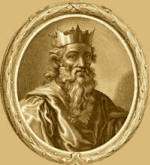
Amadeus VIII
|
Amadeus VIII
Count -
then First Duke of Savoy
(1391–1436)
|
In the
late fourteenth century, Amedeo's
eight year old grandson ascended the
Throne as Amedeo VIII, known to
history as "the Peaceful," probably
in reference to his pious reflective
inclinations. As he grew to manhood,
a certain personal quality became
manifest. Though quite devout, he
was also a warrior-knight, whose
faithful service to the Empire
earned him the title "Duke of Savoy"
in 1416. The Statuto he promulgated
for his subjects was an early
attempt at constitutional law and a
guarantee of certain personal
liberties. He retired to a monastery
in 1434, designating his son,
Ludovico, Lieutenant of the Realm,
and ceding to him the title "Duke of
Savoy," but not thereby abdicating
the Throne.
In 1439, he was elected
as the anti-Pope Felix V but
renounced this pontificate to recognise the true Pope ten years
later. The first Duke of Savoy died
in 1451, having founded the
confraternal Knights of Saint
Maurice, an institution which
survives in today's
Order of Saints Maurice and Lazarus. |
|
Duchy of Savoy
|
Situated
in the western Alps with its capital
at Chambéry, the duchy of Savoy
began as a county of the Holy Roman
Empire in the Middle Ages. During
the reign of Amadeus VIII
(1391–1436), the duchy acquired
significant territory in Piedmont,
east of the Alps, and its ruler was
promoted to the status of duke by
the Holy Roman emperor in 1416.
In
the fifteenth century, the duchy of
Savoy
included both Nice (Nizza) and Geneva |

map of
the Duchy of Savoy
1418 - 1748 |

|
 |
 |
 |
|

Capital
city:
Genova
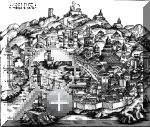
Trivia
famous Genose
Christoforo Colombo
1451 - 1506
 |
Doges of
Genova
1396-1413
-
Genoa held by the French, Dogeship
remains vacant.
Giorgo Adorno
1413–1415
Barnaba Guarco
1415
1421-1436-Milan controls Genoa,
dogeship is vacant.
Tommaso di Campofregoso
1436
- 1437
Tommaso di Campofregoso
1437?
1442, third time
|
The
Doges of Genoa are less
renowned than the Doges of Venice.
Genoa was technically a communal
republic in the early Middle Ages,
but in actuality it was an oligarchy
ruled by a small group of mercantile
families. The institution of the
doge (duke) dates from 1339. The
first doge of Genoa, Simone
Boccanegra, whose name is kept alive
by Verdi's opera, was appointed by
public acclaim in 1339. At first the
Doge of Genoa was elected without
restriction and by popular suffrage,
holding office for life in the
so-called "perpetual dogate" |
|
GENOVA
|
During
the Middle Ages and Renaissance,
Genoa developed into one of the
"Maritime Republics" (Repubbliche
Marinare) along with Venice, where
trade, shipbuilding and banking
supported one of the largest and
most powerful navies in the
Mediterranian.(
the others being Venice, Pisa, and
Amalfi) mainly oriented on the sea. The Republic of Genoa
begun spreading over the surrounding
regions obtaining the control of
almost entire Tyrrhenian Sea. Its'
alliance with the Byzantine Empire
gave it opportunities to expand into
the Black See and Crimea. The
wealthy republic begun collapsing
when the Black Death was imported
into Europe in 1349 from the Genoese
tradeing post at Caffa (Theodosia)
in Crimea destroying its economy and
killing its population. It adopted
the Venetian model of government and
was presided over by the doge. The
period was also the time of
continuous wars against Venice. The
Republic of Genoa extended over
modern Liguria and Piedmont. It had
several colonies in the Mideast, in
the Black Sea, in Sicily, Sardinia
and Northern Africa. It possessed
the island of Corsica.
Due to feuds and rivalry with Venice
it tightened political alliances
with France, but eventually was
conquered by
France in 1499 and again in
1502. It gained permanent
independence from France in 1528. |
|

|
Holy Roman Empire |
 |
 |
|
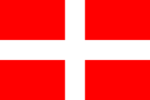
Capital
city:
Rome
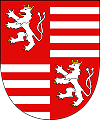
Coat of arms of
Emperor Sigismund
|
The
Holy Roman Emperor
Sigismund of
Luxembourg
14 February 1368 –
9 December 1437
|
was
King of Hungary
and
Croatia from 1387 to 1437, and
Holy Roman
Emperor for four years from 1433
until 1437, the last Emperor of the
House of Luxemburg. He was also
King of Bohemia from 1419, of
Lombardy from 1431, and of Germany
from 1411
The Holy Roman Emperor (German:
Römisch-
Deutscher Kaiser, or
"Roman-German
Kaiser") is a term used by
historians to denote a
Middle Ages ruler, who as German
King had in addition received the
title of "Emperor of the Romans"
from the
Pope of the
Holy Roman Church.
|
|
Holy Roman Empire of the German
Nation
|
For
most of its history, Germany was not
a unified state but a loose
association of territorial states
that together made up the “Holy
Roman Empire of the German Nation”.
It was a long time until the
founding of the German Reich in
1871.
he was married to
Mary of Hungary, whose mother was
killled by her husbands men...
something she never forgave
Sigismund. She died in 1395
in a suspicious horse accident while
heavily pregnant. |
|
 |

Emperor Sigismund |

Mary of Hungary |
|

|
 |
 |
 |
|

Capital
city:
Krakow
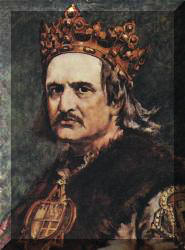
Władysław Jagiełło
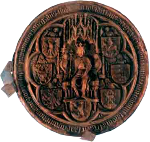
Majestic Seal of Wladyslaw II
Jagiello |
Władysław Jagiełło
II
1348-1434
King of Poland (1399–1434)
|
He ruled in Lithuania
from 1377, at first with his uncle Kęstutis. In 1386, he converted
Lithuania to Christianity, was
baptized as Władysław, married the
young Jadwiga of Poland, and was
crowned Poland's king-consort as
Władysław Jagiełło.
His own reign in Poland
started in 1399, upon death of Queen
Jadwiga, and lasted a further
thirty-five years and laid the
foundation for the centuries-long
Polish–Lithuanian union. Wladyslaw
II was the founder of the new
Jagiellon dynasty that bears his
name, while pagan Jogaila was an
heir to the already established
house of Gediminids (Gediminid
dynasty) in Grand Duchy of
Lithuania; his royal dynasty ruled
both states until 1572,and became
one of the most influential
dynasties in the late medieval and
early modern medieval Central and
Eastern Europe. |

Jadwiga
Queen of Poland,
1384-1399
called also Saint
Hedwig or Hedwig of Anjou
|
Because
of her devotion to the
church and a number of
miracles recorded
throughout her lifetime,
she was beatified in
1987. Although this
process was not
completed, Jadwiga was canonised in 1997 by Pope John
Paul II (the former archbishop of
Krakow). Her relics are located in
the south aisle of Wawel Cathedral
in Krakow.
|
|
|
Jogaila
was the last pagan ruler of medieval
Lithuania. He held the title
Didysis Kunigaikštis. As King of
Poland, he pursued a policy of close
alliances with Lithuania against the
Teutonic Knights. The allied victory
at the Battle of Grunwald in 1410,
followed by the Peace of Thorn
(1411), secured the Polish and
Lithuanian borders and marked the
emergence of the Polish–Lithuanian
alliance as a significant force in
Europe.
After
Jagiełło took the throne in Poland,
Poland and Lithuania were joined
with a union and for several hundred
years
functioned as a two-state kingdom,
known as Polish-Lithuanian
Commonwealth.
The reign
of Władysław II Jagiełło extended
Polish frontiers and is often
considered the beginning of Poland's
"Golden Age". |
Map of Poland
1386 - 1434

Poland and Lituania
Trivia
King Władysław Jagiełło
had four wives
Jadwiga of
Poland
Anne of Cilli
Elisabeth of Pilica
Sophia of Halshany
|

some of the
content on this page
is from Wikipedia
2008 - 2014
©
2008
- 2024 linda compagnoni walther
non profit site
all rights reserved
|